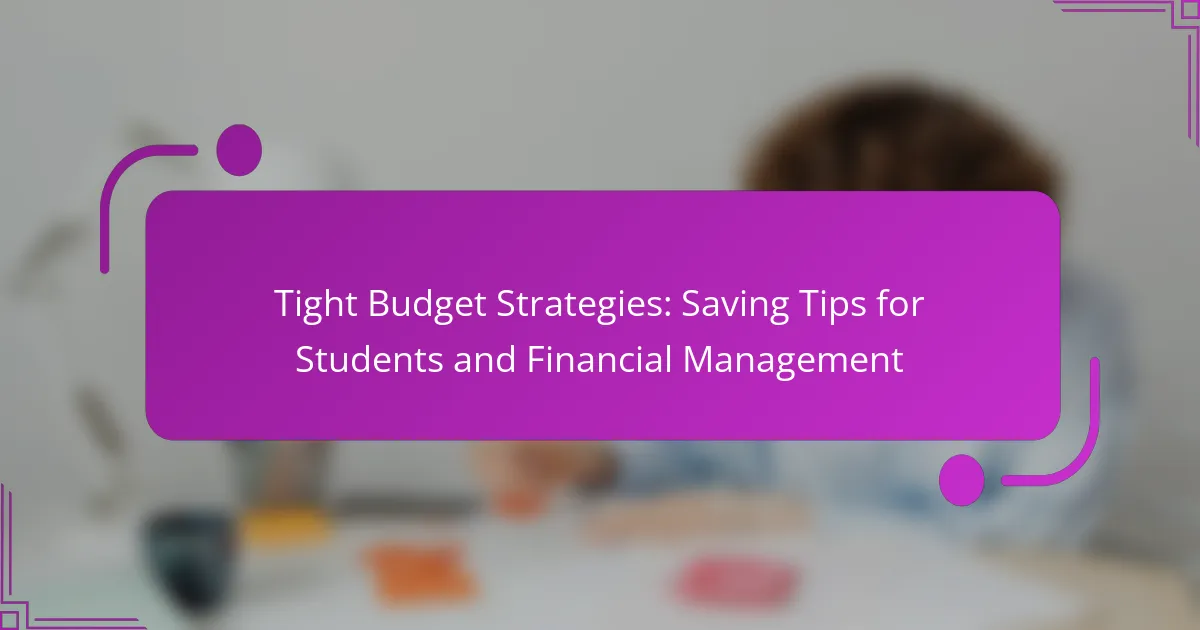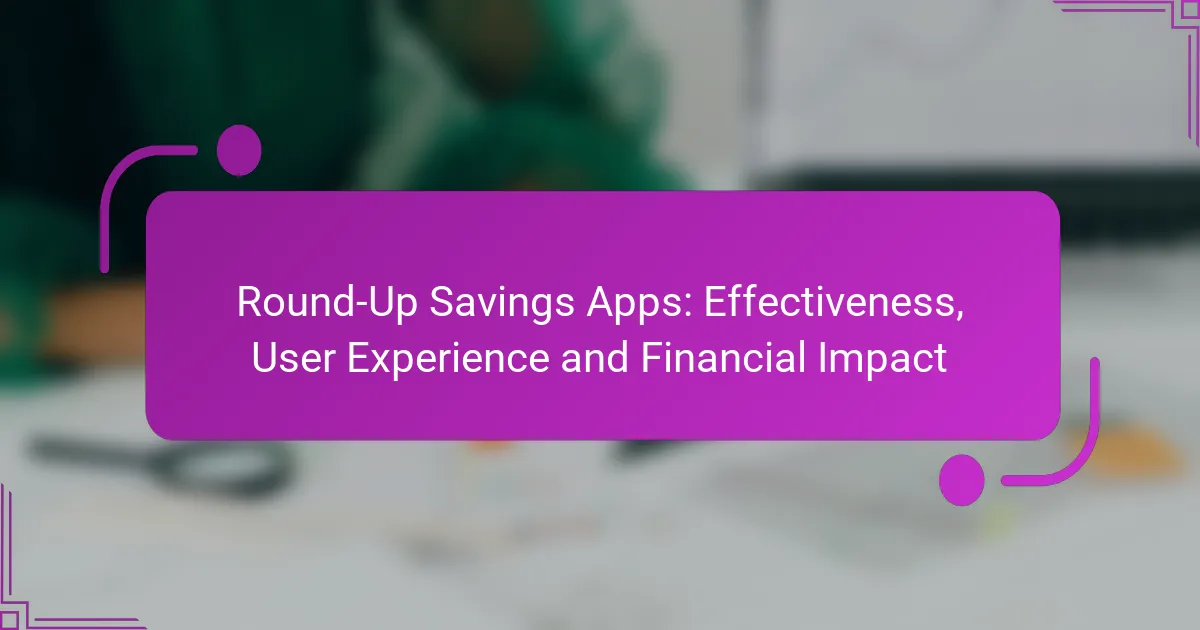Managing finances on a tight budget is crucial for students looking to make the most of their limited resources. By adopting practical strategies such as shared living arrangements, smart grocery shopping, and efficient transportation, students can significantly cut down on living expenses. Additionally, effective budgeting and leveraging discounts can help maximize savings, allowing students to focus on their essential needs without financial stress.
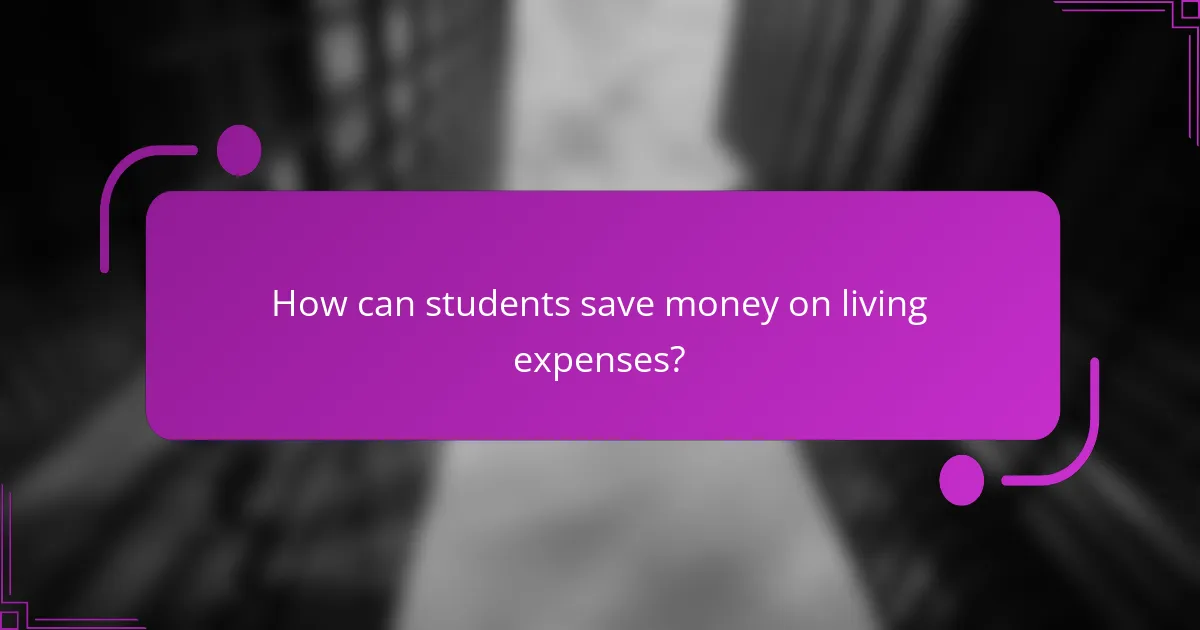
How can students save money on living expenses?
Students can save money on living expenses by adopting practical strategies that minimize costs while maximizing value. Focusing on shared living arrangements, smart grocery shopping, efficient transportation, and reducing utility bills can significantly lower monthly expenses.
Shared housing options
Sharing housing is one of the most effective ways for students to cut living costs. By renting a room in a shared apartment or house, students can split rent and utility expenses, often saving hundreds of dollars each month.
Consider co-living spaces or student housing that offer shared amenities. These options can provide a community atmosphere while keeping costs manageable. Look for listings on local rental websites or campus bulletin boards to find suitable arrangements.
Budget-friendly grocery shopping
To save on groceries, students should plan meals and create shopping lists to avoid impulse purchases. Buying in bulk and choosing store brands can also lead to significant savings over time.
Utilizing local farmers’ markets or discount grocery stores can provide fresh produce at lower prices. Additionally, consider using apps that offer discounts or cashback on grocery purchases to further stretch your budget.
Public transportation savings
Using public transportation instead of owning a car can greatly reduce living expenses. Many cities offer discounted transit passes for students, which can lower monthly commuting costs significantly.
Research local transit options and consider biking or walking for short distances to save even more. Always check for student discounts on transportation services, as these can provide substantial savings.
Utility cost reduction tips
Reducing utility costs can be achieved by adopting energy-efficient habits. Simple actions like turning off lights when not in use, unplugging devices, and using energy-efficient bulbs can lower electricity bills.
Consider setting a budget for utilities and monitoring usage regularly. Some utility companies offer programs that help students save energy and money, so inquire about available resources in your area.
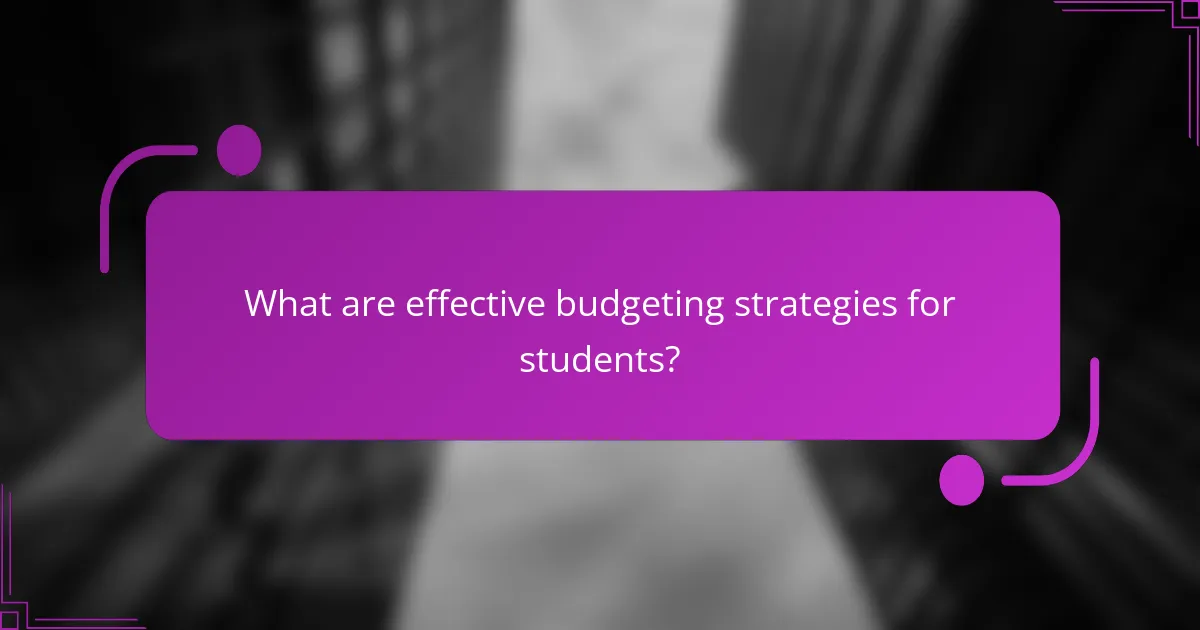
What are effective budgeting strategies for students?
Effective budgeting strategies for students focus on maximizing limited resources while minimizing unnecessary expenses. By implementing structured methods, students can better manage their finances and save money for essential needs.
Zero-based budgeting method
The zero-based budgeting method requires you to allocate every dollar of your income to specific expenses, savings, or debt repayment, ensuring that your income minus your expenses equals zero. This approach encourages conscious spending and helps identify areas where you can cut back.
To implement zero-based budgeting, start by listing all your income sources and monthly expenses. Adjust your budget each month based on your spending patterns and financial goals, ensuring that every dollar has a purpose.
Using budgeting apps like Mint
Budgeting apps like Mint can simplify financial management by tracking expenses, setting budgets, and providing insights into spending habits. These tools often categorize transactions automatically, making it easier to see where your money goes.
To get started with Mint, create an account, link your bank accounts, and set up your budget categories. Regularly review your spending reports to identify trends and adjust your budget accordingly. Many apps also offer alerts for overspending, which can help you stay on track.
Setting financial goals
Setting clear financial goals is crucial for effective budgeting, as it provides direction and motivation for managing your money. Goals can range from saving for a specific purchase, like a laptop, to building an emergency fund or paying off student loans.
To set financial goals, use the SMART criteria: make them Specific, Measurable, Achievable, Relevant, and Time-bound. For example, instead of saying, “I want to save money,” specify, “I will save $500 for a new laptop by the end of the semester.” Regularly review and adjust your goals as needed to stay aligned with your financial situation.

How can students find discounts and deals?
Students can find discounts and deals through various channels, including retailers, online platforms, and membership programs. By leveraging these resources, students can significantly reduce their expenses on everyday purchases and services.
Student discounts at retailers
Many retailers offer special discounts for students, typically requiring a valid student ID or email address. These discounts can range from 10% to 20% off regular prices, making them a valuable resource for budget-conscious students.
Popular stores like Apple, Microsoft, and various clothing brands often have dedicated student discount programs. Always check the retailer’s website or inquire in-store to ensure you are taking advantage of available offers.
Online coupon platforms
Online coupon platforms are excellent for finding additional savings on purchases. Websites like RetailMeNot, Honey, and Coupons.com aggregate various discount codes that can be applied at checkout. Students should regularly browse these sites before making any online purchase.
Additionally, browser extensions can automatically apply coupon codes during checkout, saving time and ensuring the best possible deal. Be cautious, however, as not all codes may be valid or applicable to every item.
Membership programs for savings
Joining membership programs can provide students with exclusive savings opportunities. Programs like UNiDAYS and Student Beans offer access to discounts at numerous retailers and services, often requiring a simple sign-up process.
Some credit card companies also offer student-specific cards that include cashback rewards or discounts on purchases. Always read the terms and conditions to understand any fees or requirements associated with these memberships.
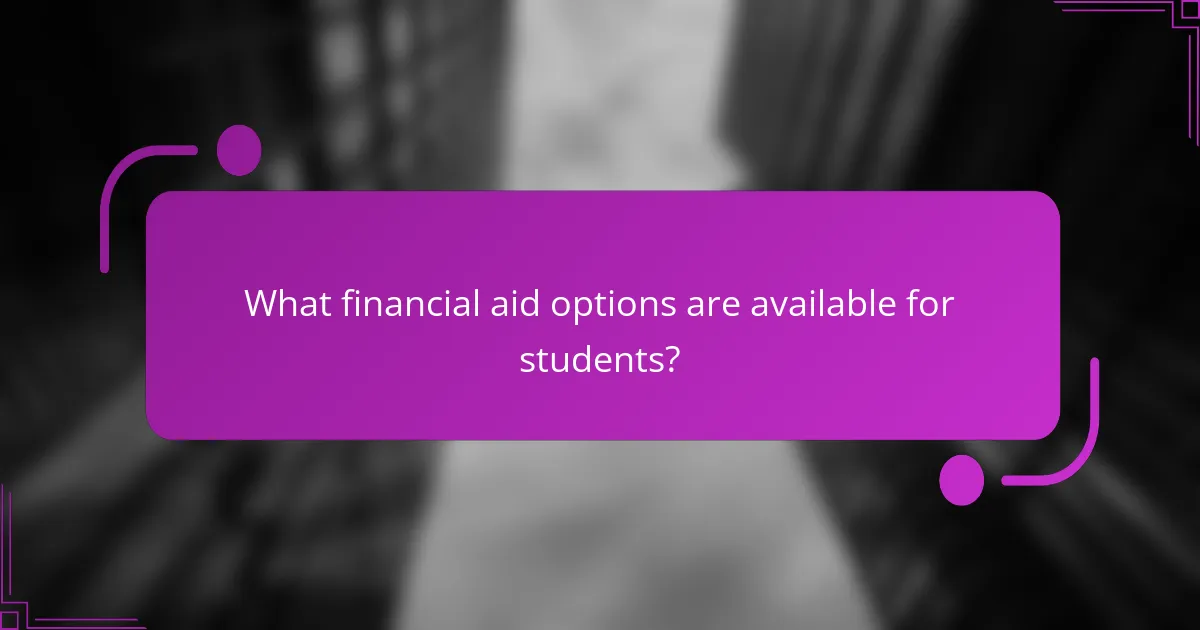
What financial aid options are available for students?
Students have various financial aid options to help cover educational expenses, including federal student loans, scholarships, grants, and work-study programs. Understanding these options can significantly ease the financial burden of college.
Federal student loans
Federal student loans are loans provided by the government to help students pay for their education. These loans typically offer lower interest rates and more flexible repayment options compared to private loans.
Students can apply for federal loans by completing the Free Application for Federal Student Aid (FAFSA). It’s important to consider the different types of federal loans, such as Direct Subsidized Loans, which do not accrue interest while the student is in school, and Direct Unsubsidized Loans, which do.
Scholarships and grants
Scholarships and grants are forms of financial aid that do not require repayment, making them highly desirable for students. Scholarships are often awarded based on merit, such as academic achievements or talents, while grants are typically need-based.
Students should actively search for scholarships and grants through their school, local organizations, and online platforms. Many scholarships have specific eligibility criteria, so it’s beneficial to apply for a variety of options to maximize funding opportunities.
Work-study programs
Work-study programs provide students with part-time job opportunities to help pay for their education while gaining work experience. These programs are often funded by the federal government and are available to students who demonstrate financial need.
To participate in a work-study program, students must indicate their interest on the FAFSA. Jobs may be on-campus or with approved off-campus employers, and earnings from these positions can help cover tuition and living expenses. Balancing work and study is crucial, so students should consider their course load when applying for work-study positions.

How can students manage debt effectively?
Students can manage debt effectively by understanding their repayment options, practicing responsible credit card use, and exploring consolidation strategies. Prioritizing these areas helps in maintaining financial stability while minimizing stress.
Understanding student loan repayment plans
Student loan repayment plans vary based on the type of loan and the borrower’s financial situation. Common options include standard repayment, graduated repayment, and income-driven repayment plans. Each plan has different terms, so it’s crucial to evaluate which aligns best with your income and financial goals.
For instance, income-driven repayment plans adjust monthly payments based on your earnings, which can be beneficial if you’re starting your career with a lower salary. Always check if you qualify for loan forgiveness programs, especially for public service jobs.
Credit card management tips
Managing credit cards wisely is essential for students to avoid accumulating debt. Aim to pay off the full balance each month to avoid interest charges, and try to keep your credit utilization below 30% of your total credit limit. This practice not only saves money but also helps build a positive credit history.
Be cautious with promotional offers and rewards programs; they can lead to overspending. Set a budget for your monthly expenses and stick to it to maintain control over your finances.
Debt consolidation options
Debt consolidation can simplify your financial obligations by combining multiple debts into a single payment, often at a lower interest rate. Students may consider options like personal loans, balance transfer credit cards, or even federal loan consolidation for student loans.
Before consolidating, compare interest rates and terms to ensure you’re getting a better deal. Be aware that while consolidation can lower monthly payments, it may extend the repayment period, resulting in more interest paid over time. Always read the fine print and understand the implications of consolidating your debts.

What are the best side hustles for students?
The best side hustles for students are flexible jobs that fit around their academic schedules and provide a decent income. Popular options include freelancing, tutoring, and part-time work in retail or food service.
Freelancing
Freelancing allows students to leverage their skills in areas like writing, graphic design, or programming. Platforms such as Upwork or Fiverr can help you find clients and set your rates based on your experience and the complexity of the work.
Consider starting with small projects to build your portfolio and gain positive reviews. This can lead to higher-paying gigs over time. Aim to dedicate a few hours each week to freelancing, balancing it with your studies.
Tutoring
Tutoring is a great way for students to earn money while helping others. You can offer your expertise in subjects you excel in, either in-person or online through platforms like Tutor.com or Wyzant.
Rates typically range from $15 to $50 per hour, depending on the subject and your qualifications. Focus on creating a flexible schedule that accommodates both your tutoring sessions and your academic commitments.
Part-time jobs
Part-time jobs in retail or food service provide steady income and often offer flexible hours. Many businesses are willing to hire students, especially during peak seasons, which can lead to additional hours.
Look for positions that allow you to work evenings or weekends. This can help you balance work with your studies while gaining valuable experience. Be mindful of your workload to avoid burnout.
